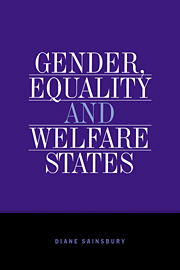Book contents
- Frontmatter
- Contents
- List of figures
- List of tables
- Acknowledgments
- Introduction
- Part I Dimensions of variation
- Part II Bases of entitlement
- 3 The male breadwinner model and women's entitlements as wives
- 4 Women's entitlements as mothers and caregivers
- 5 Women's employment and entitlements as workers
- Part III Stratification and redistributive outcomes
- Part IV Welfare state restructuring
- Notes
- References
- Index
3 - The male breadwinner model and women's entitlements as wives
Published online by Cambridge University Press: 18 September 2009
- Frontmatter
- Contents
- List of figures
- List of tables
- Acknowledgments
- Introduction
- Part I Dimensions of variation
- Part II Bases of entitlement
- 3 The male breadwinner model and women's entitlements as wives
- 4 Women's entitlements as mothers and caregivers
- 5 Women's employment and entitlements as workers
- Part III Stratification and redistributive outcomes
- Part IV Welfare state restructuring
- Notes
- References
- Index
Summary
Many women have been incorporated into the welfare state through entitlements as wives. While mainstream analysis has totally neglected this basis of entitlement, feminists have underlined its significance – placing it in a larger framework of the gendered division of labor in the family and society. An underlying assumption in earlier feminist theorizing about the welfare state was that the gendered division of labor, as typified by the male breadwinner model or the family wage, had been encoded in the social legislation of the industrial nations, and that public provision of welfare reflected and maintained traditional gender roles. Only as feminists have adopted a comparative perspective have they considered the possibility that the breadwinner model has varied in strength across countries. Yet most discussions present these variations as fairly recent developments, coinciding with women's exodus from the home into the labor market and the postwar growth of public services (Lewis 1992a, 1993, Lewis and Ostner 1991, 1994, Orloff 1993). The original assumption of the male breadwinner model as an intrinsic feature of the welfare state persists in a new guise. Now feminists suggest that the model had a decisive influence in the formative period of welfare states. Early European welfare states, it is held, were designed to fit and reinforce the family wage system, and they were basically “paternalist” (Orloff 1993: 323, Skocpol 1992).
The assumption of the pervasiveness of the breadwinner model, which has underpinned much feminist scholarship, has not been subject to systematic comparison. To rectify the situation, this chapter examines the impact of the male breadwinner model on social provision.
- Type
- Chapter
- Information
- Gender, Equality and Welfare States , pp. 49 - 72Publisher: Cambridge University PressPrint publication year: 1996



